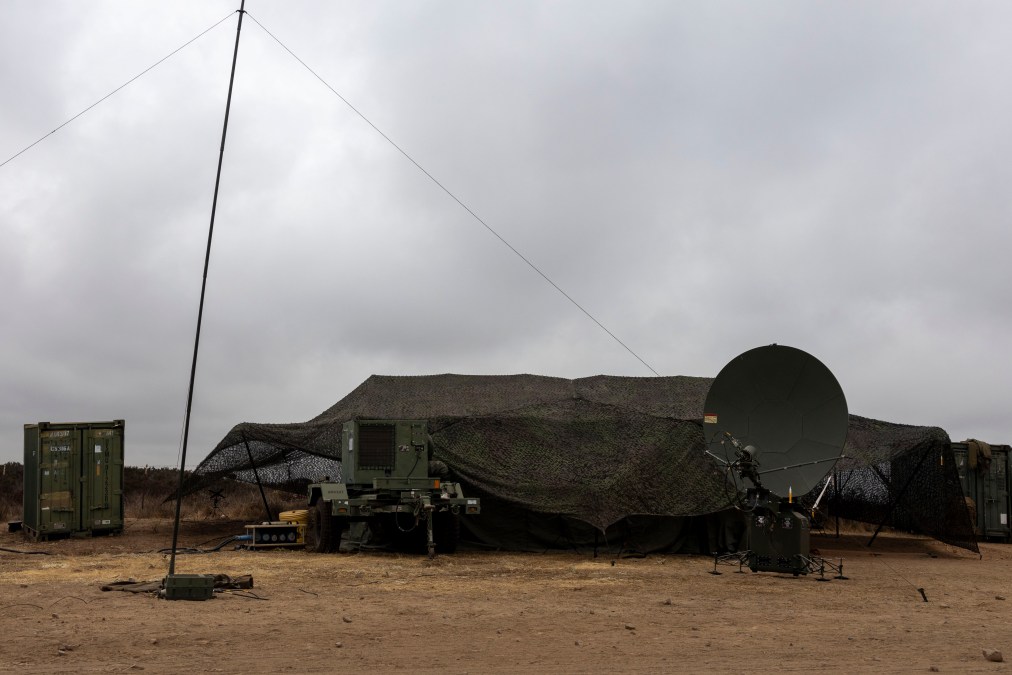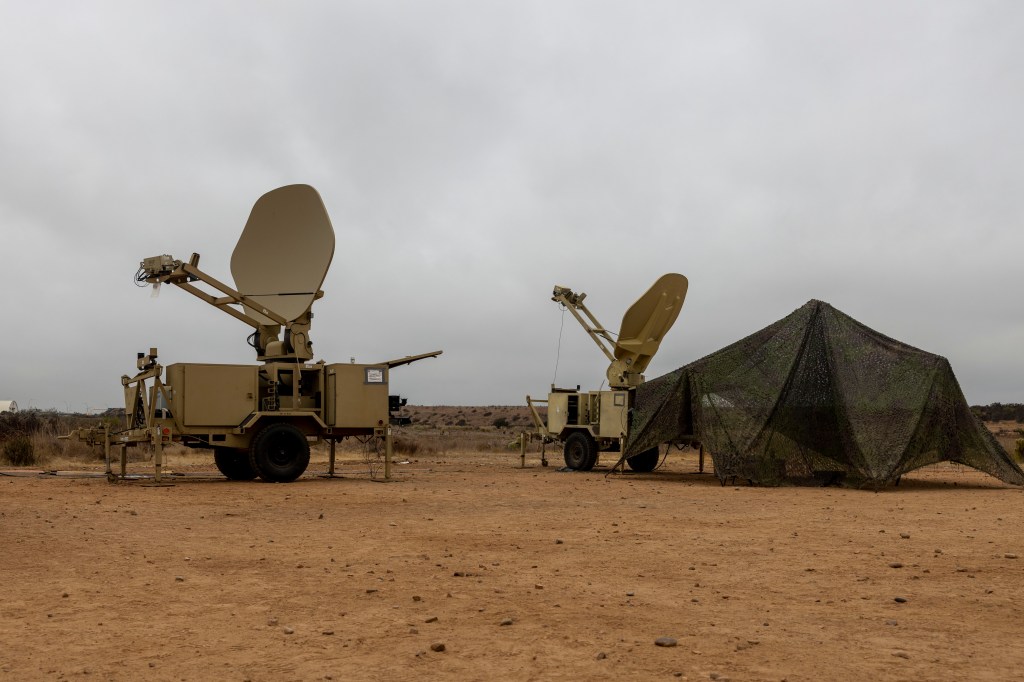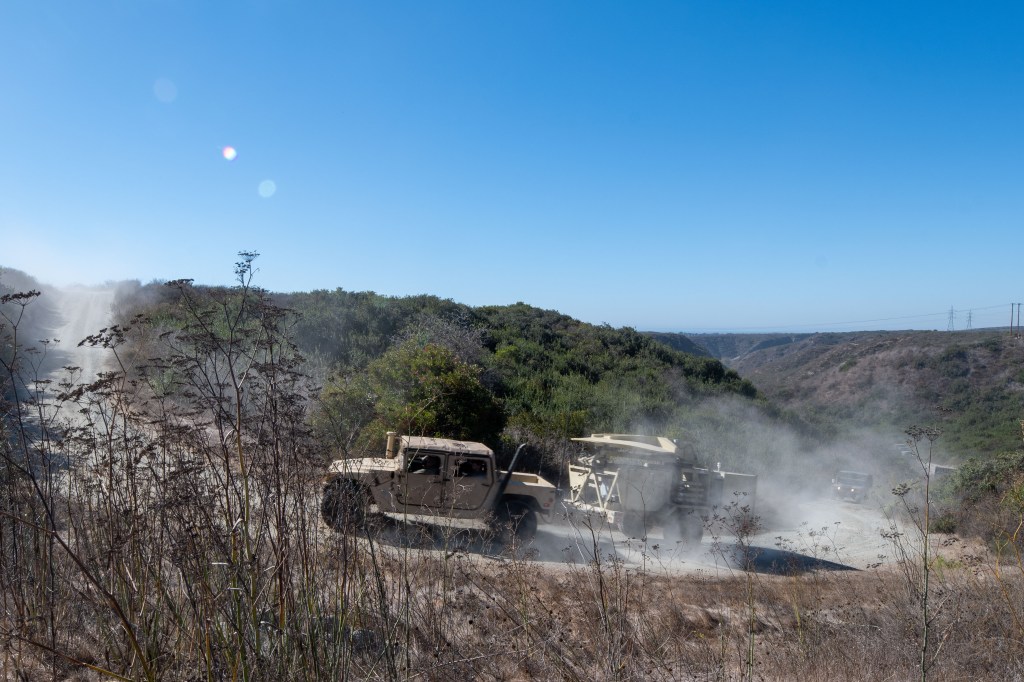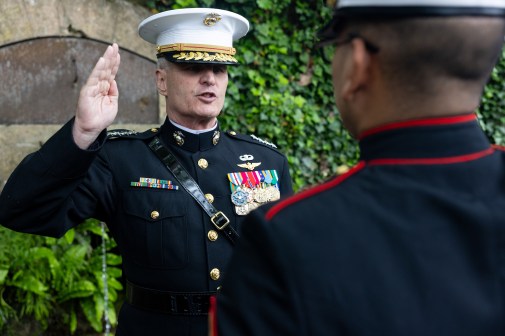Marines put comms skills to the test at Lightning Strike exercise

MARINE CORPS AIR STATION MIRAMAR, Calif. — A group of 14 communications Marines was tasked with establishing comms for the logistical hub of the Marine Air Wing. Despite how complicated network equipment can be, it should have been an easy enough task for the group of comms personnel — until their position came under attack by the enemy.
In the middle of establishing a Marine Air Traffic Control Mobile Team, the small unit was forced into defensive positions to protect its area. As the old adage goes: Every Marine a rifleman.
Fending off three “red cells,” the unit was able to defend its area and successfully establish communications for those in the Aviation Ground Support Operation Center who perform combat engineering, logistical support and airfield operations.
In a future operating environment, such as the island chains in the Pacific, smaller, more dispersed units will be tasked with defending their areas while establishing communications nodes to enable operations for the air wing.
Such was the scenario at the Lightning Strike, an exercise that took place in October at Marine Corps Air Station Miramar that sought to test the communications squadron in Marine Air Control Group 38’s ability to establish 15 communications nodes, as opposed to the eight nodes they were responsible for in the past – in addition to meeting the mission-essential tasks of the unit.
Much like the rest of the military, the Marine Corps is evolving the way it operates as part of an overall shift from 20 years of counterinsurgency operations to so-called great power competition. The National Defense Strategy names China as the “pacing threat,” and with that, the armed forces must alter how they are structured to counter a sophisticated military in a complicated region that is dominated by vast seas, enormous distances and numerous islands.
As part of the Marine Corps’ Force Design and its commandant’s planning guidance efforts, the Corps’ wings are shifting from mostly static bases to launch aircraft, as it did in Iraq and Afghanistan, to a hub-spoke-node model moving forward. This means forces will be spread out and dispersed across the battlespace, likely on several islands, and as a result, the control group — which is responsible for establishing communications and command and control capabilities for aviation elements in the field — must alter its operating concept to support these dispersed air units as well.
Lightning Strike “also had to be evolving the comm squadron to support the Marine Aircraft Wing, based off the way the Marine Aircraft Wing is being employed in support of Force Design 2030. If the wing is now being employed more for a hub, spoke and node model, and more distributed, then the comm squadron has to be able to do that as well,” Lt. Col. Brian Kerg, commander of Marine Wing Comm Squadron 38, said in an interview.
Officials explained that Lightning Strike was a way for the unit to signal to the commandant that it understood the planning guidance and force design.
The exercise sought to examine, with current programs of record and tables of equipment, if the comm squadron could support the communications the wing demands. Many of the legacy programs of record are not only clunky to drag around the battlefield — such as VSAT Larges that are vehicle-towed — but also can take a while to set up, tear down, establish communications and have limited throughput. As part of the exercises, forces were given several pieces of commercial off-the-shelf equipment to augment the programs of record that are not only more mobile but have several orders of magnitude more throughput, such as Starshield and Kymeta terminals, and also provide diversity of transport, a key tenet for future warfare if systems are jammed or blocked by the enemy.

“The way [the comm squadron’s] table of organization and equipment was written was not for that type of employment concept,” Col. Jason Quinter, commander of Control Group 38, said in an interview, regarding the legacy model for deploying. “What the squadron commander, Lt. Col. Kerg, is trying to figure out is: Do they have enough capacity to support the entire wing? … They’re spread out in 15 separate locations right now and they’re maxing out their equipment and their people to see if they can pull that off.”
Quinter believes the right mix of capabilities won’t necessarily be a major issue. Instead, he’s concerned with capacity, especially given the unit won’t be given more personnel but will be spread out more to establish 15 nodes, which means smaller units in the field.
“I’m pretty confident they have the right capability. Capacity is probably going to be the more important question … do they have enough people? Is the squadron big enough to be able to do that? I don’t know what the answer will be,” he said.
Testing comms Marines
The 2024 iteration marked the second of Lightning Strike, albeit a significantly larger one. Officials noted this year’s event was a slow build-up throughout the two weeks, described as a crawl, walk, run format.
Marines began the initial stages of the exercise using primarily legacy communications systems and adding more advanced systems including the commercial capabilities as the event progressed.
“That’s kind of the scenario that we painted was we didn’t have the Starshields and the COTS terminals in the first three days. We got up on services, we became [fully operational], and then we could tie in the COTS — both teaching the communicators how to do the old method but also the new method at the same time,” said Capt. Dakota Newsome, operations and executive officer for Bravo Company in Comm Squadron 38. “As we progress too, we realize that we need to have more throughput at some of these smaller sites. We used to send maybe single-channel radio out on some of these sites and that’s how they would have the feedback. But now, since we have these COTS terminals that we can start dropping and start enabling that NIPR, SIPR services at the lowest warfighter, like at the edge, like those edge devices can actually C2 back all the way to the” Tactical Air Command Center.
The various organizations throughout the exercise begin at the largest, most static — the Marine Air Group headquarters — getting more and more austere all the way down to a four-Marine team at the forward arming and refueling points with just a single-channel radio that can provide refuel aircraft in the field.
Establishing the 15 nodes not only provides more diversity of transport and more communications options, but, officials explained, it also allows for more purpose-built comms units.
“It also allows us to send out more nodes that do specific functions,” said Capt. Hipolito Ozuna, S3 alpha operations. “So everyone performs a specific function. What we do is we enable more of those specific functions to be able to be employed through our communication system. We’re able to essentially create more task-purpose nodes throughout” the event.
As part of force design and the changes within the Corps, the service is getting more organized comms platoons. In the past, when they would deploy, a unit wouldn’t necessarily know who they were getting, they just needed bodies and ranks without knowing what those people’s specialties were, officials said.
Now they have actual job titles for the platoons such as SATCOM operator or S6, for example, meaning the units are more task-purposed.
Events such as Lightning Strike allow these communications personnel to practice some of the skills they need to perform where they traditionally might not get many opportunities for such training.
“Our unit usually doesn’t do this type of stuff. In my MOS, for the last couple years, we sit in like a [combat operations center] and just pass basic information. This is a lot more upscale and it’s a lot of good training for my junior Marines. They haven’t gotten this type of training yet, which is good for them, whether it be passing, hey we need this patrol to go out with this bunch of people, rifles, whatever it may be, it’s good for them to be able to get that training now, so in case of a war to break out, we’re able to have them not on their toes, they’re kind of more relaxed and they understand. They’re very calm with the way they pass their traffic,” said Sgt. Brandon Froio, transmission systems operator supervisor. “I like this personally for my juniors because it’s high stress and being able to put them on their toes now, instead of when we’re out there actually in a fight that they’re going to screw up out there, I’d rather them screw up here and get the training they need to be able to go out there and be like, okay this is nothing. I’ve already done this for x amount of times, I got this, this is no problem.”

Another key aspect is the exercise provided an opportunity for Marines to test their military skills, defending their area to set up communications against an opposing force trying to contest them.
“We’re not just teaching the communicators how to communicate, but also how to do those mil skills. Right now, for example, they do have a recon patrol out, there is an enemy patrol en route here and they just got issued an order to actually go interdict that recon patrol. Not just understanding how to communicate, but also like, ‘Hey, there’s an enemy threat out there,’” Newsome said.
In line with the tenets of force design, the expansion of 15 nodes and smaller teams will help enable the Corps as the so-called “stand-in” force, a vision the Corps has of being the forward presence for the joint force in theater as the eyes and ears. This means that Marines must be more professional and capable in these smaller teams to enable those comms while fighting off the enemy — something Lightning Strike allows them to hone.
‘Game-changing’ equipment
Officials explained that the unit was able to successfully go from eight to 15 nodes providing communications over a geographically dispersed area — seven nodes at Miramar, seven at Camp Pendleton over 30 miles away and a node at the unit’s headquarters.
Such an operational concept will be crucial not just for efforts the Corps has underway, but also for larger efforts spurred on by the Pentagon, such as Combined Joint All-Domain Command and Control, which envisions how systems across the entire battlespace from all the services and key international partners could be more effectively and holistically networked to provide the right data to commanders, faster. The word “combined” in the parlance of CJADC2, refers to bringing foreign partners into the mix.
“The short version on that is how can the DOD focus on every sensor to every shooter? That’s a great tagline and that’s the desire, that’s the outcome, but that overshadows or overlooks the architecture in the middle that allows every sensor to talk to every shooter, and that’s a big ask. Now you’re looking at Marines like these figuring out how that actually works and not just our communications networks we already have, but tying more sensors into that architecture and add that Marine Air Wing in particular, we have increasingly more and more sensors that allow for aviation command and control and control of aircraft and the content of the functions of marine aviation,” Kerg said. “You have some that are programs of record, you have some that are commercial off-the-shelf and they’re coming at a faster and faster pace and you have some that are experimental.
Kerg continued: “We’re putting an even greater load on the network … If we’re not managing [everything] correctly, then you may get a track, but it might not be target quality or you may not get a track at all. That’s where this all fits in, connecting every sensor to every shooter and our Marines managing the network in an exercise like Lightning Strike is what allows the MAW commander to fight that way … and to be able to support Force Design 2030, which allows us to fit our will with respect to the National Defense Strategy.”
Marine Air Control Group 38 is at the forefront of helping the Corps experiment with CJADC2 concepts, even constructing a CJADC2 lab. In fact, Quinter, who previously served on the Joint Staff’s J6 team when it was developing the overarching concept for CJADC2, wrote the concept paper for Project Dynamis, which ended up being adopted as the Corps’ approach to CJADC2.
“We’ve created our own JADC2 lab and we are experimenting at the speed of funding. Basically, we don’t have extra funding. Essentially, leveraging relationships and the people I’ve met over the last three years since I’ve been working on this and spending a little bit of [operations and maintenance] dollars to get after some stuff,” Quinter said. “Mostly what we’re able to get after are things that are where the Marine Corps is caught up to that particular technology and we’re in a place where headquarters Marine Corps is helping us.”
By utilizing commercial off-the-shelf gear, the units are able to be not only faster and more nimble on the battlefield but also support greater comms capacity, an enabler for the Corps and the joint force.
“We’re taking the latest and greatest in technologies, Starshields and other COTS equipment, and incorporating into the formations to see how we can employ them to become a little more lethal and more capable as a force,” Ozuna said.
Others explained that to establish some of the sites, such as the Marines Aircraft Group headquarters, one of the largest, it initially took almost three days. But with Starshield, they were up in under 12 hours.
Officials have also in the past described capabilities such as proliferated low-Earth orbit satellite communications – such as Starlink – as game-changing technologies and said it’s possible the results from the exercise could help inform future procurement.
At the end of the exercise, Marine Air Control Group 38 leaders walked away confident that the unit can support the Marine Air Wing commander by providing 15 nodes and closing every sensor to every shooter. They also learned lessons about deploying the squadron as a whole, as opposed to sending detachments forward.
Overall, the forces learned new tactics and operating procedures that will likely be incorporated into operations in the future and used to help shape the next iteration of the exercise.






